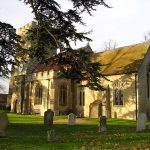Biddenham lies in a loop of the River Great Ouse, before it reaches Bedford, some two miles away. It has a church, three schools, a War Memorial, a private hospital, and a village pub. A village hall and a secondary pavilion with grounds, are actively used for sports and other village activities.
There has been a settlement here since before Roman times. Stone age implements were found near the church in 1861, which are now in the British Museum. Roman remains, such as pottery, coins and bits of sculpture have also been found in the area, and Saxon mirrors and scrolls, which are now in the British Museum. By the Seventh Century Biddenham was in the Kingdom of Mercia, which became Christian in AD/CE 653. The Danes held much of Bedfordshire from 835 – 1016. And in 1086 after the Norman Conquest an inventory was taken of everything in England, which was known as the Domesday Book. In this only one manor is mentioned in Biddenham – that of Forde End (sadly demolished in 1967). It belonged to a William Spek (Le Espec), who had obtained this manor in exchange for Toddington.
From 1086 to the Twentieth Century Biddenham was largely a farming and rural community. There were still six farms in 1900. But thereafter people had to start finding employment outside the village. Today most people living in Biddenham work in Bedford or commute to London, Milton Keynes, Cranfield, or further afield. The only jobs in the village today are in the church, the pub, the schools, the Golf Clubs, the pavilion and the private hospital.

The church, a ‘listed grade I’ building, is dedicated to St James the Great. and dates probably from Saxon times but the nave is considered to be of Norman origin, the tower twelfth century, the lower bell tower thirteenth century, the chancel fourteenth century, the south aisle, porch and parvis fifteenth century, the north aisle sixteenth century and the vestry and church barn conversion twentieth century. Four architectural periods are represented in the church, Norman, Early English, Decorated and Perpendicular. The stained glass is Victorian or Twentieth Century. The living since 1967 has belonged to the Bishop of St Albans.
Many thatched cottages remain from the Seventeenth Century, and other houses are from the Eighteenth, Nineteenth and Twentieth Centuries, some of which are ‘listed’ as being of special historic or architectural interest. Some are by the eminent architects Charles Edward Mallows (1864-1915) and Mackay Hugh Baillie Scott (1865-1945). (See A Walk Round Biddenham Village by Dorothy Richards, price £1. plus AS sae from 6 Bromham Road, Biddenham, Bedford MK4O 4AF) This was originally part of the book Biddenham, A Parish History & Guide (1991) by Dorothy Richards, now sadly out of print, but which can be obtained from Bedfordshire Libraries.

Part of the village, where there are stone houses, thatched cottages and open greens, and the section from the village green to the church, forms a conservation area, where further development and all the trees are protected. Other important trees in the village have preservation orders upon them. Since 1986 the village pond has been restored and maintained as a wild life and amenity area for village residents. Next to the pond (which lies on an ancient Causeway or Coffin path leading from Gold Lane, behind the manor to the church) there used to stand a spectacular Dovecote. It was built in 1706, restored in 1932 and unaccountably bulldozed down in 1966, a great historic loss to the village.
Bromham Bridge, known as Biddenham Bridge until 1728, is scheduled as an ancient monument. It has 22 arches in Biddenham and four in Bromham. It is first mentioned in the thirteenth century and probable that the long section over the flood meadows was built in the eighteenth century. It was a toll bridge with a chantry chapel in the middle ages.
